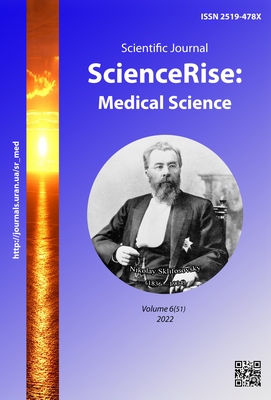A clinical-epidemiological study of facial dermatoses in women
DOI:
https://doi.org/10.15587/2519-4798.2022.268941Keywords:
facial dermatoses, melasma, occupation, pigmentary dermatoses, immunobullous dermatoses, hyperpigmentary dermatoses, dermatosis papulosa nigra, pemphigus vulgaris, seborrheic keratosesAbstract
The face is the most prominent part of the body. Facial blemishes and disorders directly reflect a person's physical appearance, cosmesis and self-image. They may contribute to dysmorphism and even lead to depression in susceptible individuals, especially women. Early identification and management of facial skin disorders are therefore important.
The aim: To study the clinical pattern and epidemiological determinants of facial dermatoses among females above 10 years.
Methods: This cross-sectional study was conducted among female patients with facial dermatoses, with informed consent, at a rural tertiary hospital for 18 months.
Results: A total of 500 patients were enrolled. The majority were in the 4th and 5th decades. Pigmentary dermatoses were highest, melasma predominating. Immunobullous dermatoses formed the smallest group. Occupation-wise, the majority were agricultural labourers. Many dermatoses, especially melasma, were related to occupation and lifestyle with photo-aggravation, cosmetics use and stress.
Conclusion: This study assessed the pattern of facial dermatoses among the female clientele of this institution. Hyperpigmentary dermatoses, especially melasma, emerged as the most common dermatosis for which treatment was sought
References
- Chaurasia, B. D. (2004). Scalp, temple and face in human anatomy regional and applied dissection and clinical. Vol. 3. CBS publishers, 45–65.
- Bhat, Y., Latief, I., Hassan, I. (2017). Update on etiopathogenesis and treatment of Acne. Indian Journal of Dermatology, Venereology and Leprology, 83 (3), 298–306. doi: https://doi.org/10.4103/0378-6323.199581
- Schäfer, T., Kahl, C., Rzany, B. (2010). Epidemiologie der Akne. JDDG: Journal Der Deutschen Dermatologischen Gesellschaft, 8, S4–S6. doi: https://doi.org/10.1111/j.1610-0387.2009.07167.x
- Durai, P. C., Nair, D. (2015). Acne vulgaris and quality of life among young adults in South India. Indian Journal of Dermatology, 60 (1), 33. doi: https://doi.org/10.4103/0019-5154.147784
- Tatu, A., Ionescu, M., Cristea, V. (2017). Demodex folliculorum associated Bacillus pumilus in lesional areas in rosacea. Indian Journal of Dermatology, Venereology and Leprology, 83(5), 610. doi: https://doi.org/10.4103/ijdvl.ijdvl_921_16
- Vashi, N. A., Kundu, R. V. (2013). Facial hyperpigmentation: causes and treatment. British Journal of Dermatology, 169, 41–56. doi: https://doi.org/10.1111/bjd.12536
- Agarwal, P., Gajjar, K., Mistry, A. (2019). A clinico-epidemiological study of facial melanosis at a tertiary care center in Gujarat. Pigment International, 6 (2), 96–101. doi: https://doi.org/10.4103/pigmentinternational.pigmentinternational_30_18
- Yalamanchili, R., Shastry, V., Betkerur, J. (2015). Clinico-epidemiological study and quality of life assessment in melasma. Indian Journal of Dermatology, 60 (5), 519. doi: https://doi.org/10.4103/0019-5154.164415
- Handel, A. C., Miot, L. D. B., Miot, H. A. (2014). Melasma: a clinical and epidemiological review. Anais Brasileiros de Dermatologia, 89 (5), 771–782. doi: https://doi.org/10.1590/abd1806-4841.20143063
- Xiao, A., Muse, M. E., Ettefagh, L. (2022). Dermatosis Papulosa Nigra. StatPearls. Treasure Island: StatPearls Publishing. Available at: https://www.ncbi.nlm.nih.gov/books/NBK534205/
- Hassan, I., Bhat, Y., Aleem, S., Anwar, P. (2015). A clinico-epidemiological study of facial melanosis. Pigment International, 2 (1), 34–40. doi: https://doi.org/10.4103/2349-5847.159394
- Sheth, P., Shah, H., Dave, J. (2014). Periorbital hyperpigmentation: A study of its prevalence, common causative factors and its association with personal habits and other disorders. Indian Journal of Dermatology, 59 (2), 151–157. doi: https://doi.org/10.4103/0019-5154.127675
- Siew-Keah, L., Patrick, M. F. V., Chuen, C. S., Keat, T. C., Weng, C. K., Kek, L. C. et al. (2018). Evaluation of histopathological changes in idiopathic cutaneous hyperchromia at the orbital region. Surgical & Cosmetic Dermatology, 10 (3). doi: https://doi.org/10.5935/scd1984-8773.20181031178
- Raghavendra, K., Soni, B., Yadav, D., Kumawat, P., Singhal, A. (2017). A clinico-epidemiological study of hypopigmented and depigmented lesions in children and adolescent age group in Hadoti region (South East Rajasthan). Indian Journal of Paediatric Dermatology, 18 (1), 9. doi: https://doi.org/10.4103/2319-7250.188463
- Mahdi Jassim, H. (2020). Pityriasis alba: an epidemiological and clinical study. International Journal of Advanced Research, 8 (3), 875–880. doi: https://doi.org/10.21474/ijar01/10701
- Lynn, D., Umari, T., Dellavalle, R., Dunnick, C. (2016). The epidemiology of acne vulgaris in late adolescence. Adolescent Health, Medicine and Therapeutics, 7, 13–25. doi: https://doi.org/10.2147/ahmt.s55832
- Swathi, G., Kusagur, M. S. (2015). A Clinico-Epidemiological Study of Acne in Adults. International Journal of Science and Research (IJSR), 4 (11), 822–825. doi: https://doi.org/10.21275/v4i11.nov151241
Downloads
Published
How to Cite
Issue
Section
License
Copyright (c) 2022 Nallamilli Spandana Reddy, Janardhan A. Upadhyaya, Col. G K Prasad

This work is licensed under a Creative Commons Attribution 4.0 International License.
Our journal abides by the Creative Commons CC BY copyright rights and permissions for open access journals.
Authors, who are published in this journal, agree to the following conditions:
1. The authors reserve the right to authorship of the work and pass the first publication right of this work to the journal under the terms of a Creative Commons CC BY, which allows others to freely distribute the published research with the obligatory reference to the authors of the original work and the first publication of the work in this journal.
2. The authors have the right to conclude separate supplement agreements that relate to non-exclusive work distribution in the form in which it has been published by the journal (for example, to upload the work to the online storage of the journal or publish it as part of a monograph), provided that the reference to the first publication of the work in this journal is included.









